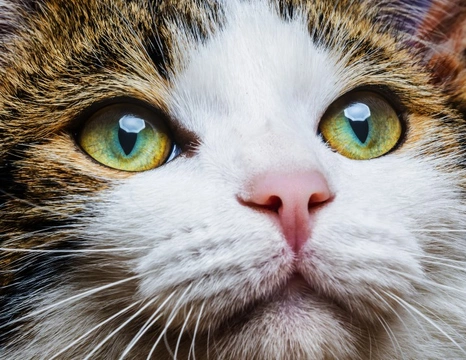Pets
Pets for studWanted petsBreedersAccessories & services
Knowledge hub
Support
Support & safety portal
Why do cats’ eyes glow in the dark?
Anyone who has been outside taking in the view at twilight or during the evening will probably be familiar with the concept of spotting a pair of disembodied, shining eyes peering out of a hedge or from across the road, only to realise that said eyes actually belong to one of the local cats!
The reflective nature of cats’ eyes in dusk, twilight and near dark is not totally unique to cats-other animals display it as well-but it is not something that also happens to humans, which is why we often get a start when seeing a cat’s eyes suddenly reflecting back at us from nearby!
The same effect can be observed if you take a photo of your cat in dim lighting using the flash-your cat’s eyes will appear luminous and almost ethereal in the resulting picture!
But why do cats’ eyes glow in the dark, what is the purpose of it, and how does it happen? Read on to learn more.
Night vision
When it comes to vision, a whole range of different elements combine to dictate what any animal cannot see, such as how well they can see in different types of lighting, what colour range they can identify, and how near and far they can view things clearly.
Many people assume that cats are nocturnal, when in fact they are crepuscular-which means that they are most active in half light, such as around dawn and dusk. Their vision too has evolved to function at peak efficiency during these times-which is why cats have a much better ability to see in the dark and in dim lighting than people do, and yet, poorer vision during the day in full light.
Cats only need a sixth of the ambient lighting that humans do to be able to see clearly, and their ability to see in the dark is increased by an additional structure in the retina of the eye that cats and many other animals possess, but that people don’t-and this is called the tapetum lucidum.
The tapetum lucidum effectively functions like a tiny mirror in the back of the eye, to reflect more of the light that the eye receives and so, improve the night vision. This same structure is what makes the eyes of the cat glow in the dark as well, because it essentially reflects light, such as ambient lighting or the flash of a camera back at you.
Our understanding of this structure has also had a wide scale impact on public safety on the roads too-cats’ eyes reflectors in the centre of the road are designed to reflect lighting from cars’ headlights back to their drivers of the cars, clearly enough to allow them to see the centre of the road, but not so brightly as to impair their vision!
Colour vision
Many people assume that cats cannot see in colour, and this is not true-cats have colour vision, but they cannot see as many different colours as people can, and also, they do not see as deep colour saturation-so for instance, while people would be able to pick many different shades of green out of a rural landscape, for cats, this will appear less bright, and contain fewer shades of green.
Cats can see colours in the green and blue spectrum, but reds, pinks and oranges less so-it is possible that they perceive colours in this range as additional shades of green, and colours such as lilac that combine a colour that they can see (blue) with one that they potentially cannot (red) are likely to appear as another shade of blue.
Near and far sightedness
In the wild, cats rely on their hunting skills to feed themselves, which is largely responsible for a great many of the common traits of our domestic cats-such as a propensity to sleep a lot in between bouts of high activity, a strong prey drive, and lots of patience when hunting!
Cats hunt by either stalking their prey or lying in wait perfectly still until the time is right for them to pounce, when they orient themselves and move quickly to catch and disable their prey before it can escape.
Cats do not seek out and pursue prey from long distances away, which means that for cats, it is much more important to have sharp, clear near vision than distant vision.
This means that cats are short-sighted and able to pick out huge amounts of detail from things that are close to them, particularly when it comes to detecting tiny movements-but over distances of larger than around 15-20 feet, the cats’ vision progressively worsens, so that things in the distance quickly become blurry and hard to identify, due to a combination of short-sightedness and an inability to view the full range of different shades and hues that people can.



